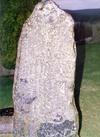| Culsh souterrain or earth house |
|---|

Souterrains are a type of iron-age architecture that seems to have been fairly common in the area that is now Aberdeenshire, the most common assumption is that they were used for storage of grain and other food-stuffs. Souterrain curved and lined with dry stone walls (the walls have been mortared in modern times) and heavy roof slabs. Accessible but the visitor will require a torch to explore the few metres of passageway inside. |
| In the beginning, Tarland |

Sculpture using engraved granite one large and three smaller stones, that clearly references local precedents particularly from the neolithic and megalithic periods in both the style and decoration of the piece and, of course, the title. More Information |
| Migvie Class II Pictish Symbol Stone |

Class II Pictish Symbol Stone 180 x 70 x 38 cm. A low relief cross composed of coarse double interlace is carved in low relief on the east face from the angles of the arms and the top corners of the cross there are short projections ending in rings, which may represent hanging rings. In each quadrant is a symbol in very low relief. Upper left a small clumsy double disc and z rod, upper right even smaller horseshoe and v rod. To the lower right the remains of a mounted figure and two lower left a pair of shears the only known example of this symbol. On the reverse of the stone is a long haired horseman in low relief. This stone is striking by comparison to most Class II Pictish stones in the amateurishness of its execution. I can imagine a customer who could not come at the price demanded by a professional sculptor and instead commissioned a local handyman who was a bit out of his depth. The rider on the reverse seems much more accomplished perhaps a good stencil? More Information |
| Tillylodge viewpoint indicator |

Offers spectacular views over the River Dee Valley and known as the Queen’s View with claims that Queen Victoria stopped to admire the vista to the distant Mountain of Lochnagar. The Indicator was erected in 1970 by the Deeside Field Club to mark its Jubilee. |
| Tomnaverie (Tarland) Stone Circle |

The recumbent stone circle is a form unique to North East Scotland. |
This content was submitted by external contributors and does not necessarily reflect the views of the University of Aberdeen.
